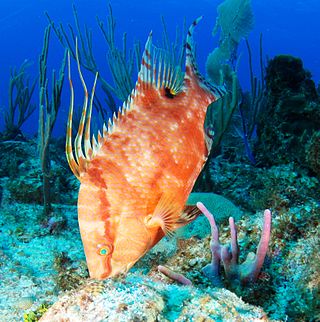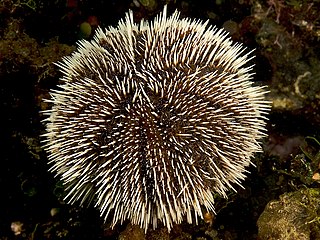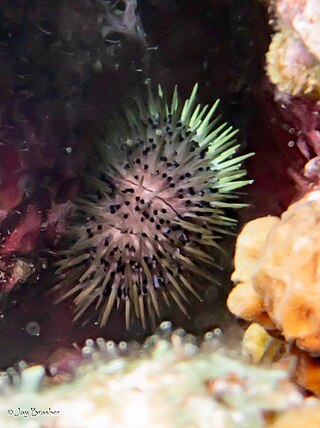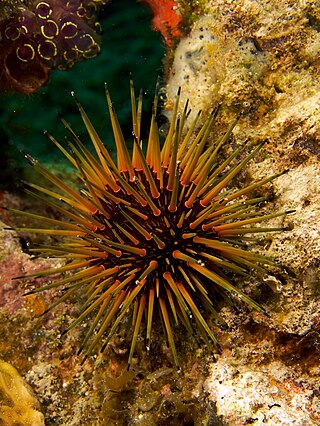
The hogfish, also known as boquinete, doncella de pluma or pez perro in Mexico is a species of wrasse native to the Western Atlantic Ocean, living in a range from Nova Scotia, Canada, to northern South America, including the Gulf of Mexico. This species occurs around reefs, especially preferring areas with plentiful gorgonians. It is a carnivore which feeds on molluscs, as well as crabs and sea urchins. This species is currently the only known member of its genus.

Diadema antillarum, also known as the lime urchin, black sea urchin, or the long-spined sea urchin, is a species of sea urchin in the family Diadematidae.

Stegastes, commonly known as Gregories, is a genus of ray-finned fish in the family Pomacentridae. Members of this genus are marine coastal fishes except for S. otophorus, which also occurs in brackish water. These fish are known by the names of damselfish, gregory and major. They are small tropical fish associated with coral and rocky reefs in the Atlantic, Indian and Pacific Oceans. They are sometimes found in the aquarium trade where they are an easy-to-keep fish, but they do not mix well with other fish of their own or other species because of their territorial habits and aggressiveness.

The mottled grouper is a species of marine ray-finned fish, a grouper from the subfamily Epinephelinae which is part of the family Serranidae, which also includes the anthias and sea basses. It is found in the eastern Atlantic Ocean and the Mediterranean Sea.

Meoma ventricosa, known by the common names cake urchin and red heart urchin, is a large species of sea urchin which lives in shallow waters in the Caribbean. It may reach a diameter of twenty centimeters and is covered in reddish-brown spines. It has both pentagonal radial symmetry and bilateral symmetry, giving it a sand-dollar appearance; however, two of its five sections are merged more closely than the others.

Astropyga radiata, the red urchin, fire urchin, false fire urchin or blue-spotted urchin, is a species of sea urchin in the family Diadematidae. It is a large species with long spines and is found in the tropical Indo-Pacific region. It was first described in 1778 by the German naturalist Nathaniel Gottfried Leske.

Lytechinus variegatus, commonly called the green sea urchin or the variegated sea urchin, is a species of sea urchin that can be found in the warm waters of the western Atlantic Ocean and Caribbean Sea.

Loxechinus albus is an echinoderm of the family Parechinidae, native to coastal southern South America, ranging from Ecuador, along the entire coasts of Peru and Chile, to Argentina, as well as the Falkland Islands. It is the only species in the genus Loxechinus. It is known as the Chilean sea urchin or red sea urchin, but the latter name is typically used for the North Pacific Mesocentrotus franciscanus and it is not the only species of sea urchin in Chile. L. albus is found on rocky reefs and shores in the intertidal and subtidal zones to a depth of 340 m (1,120 ft).

Centrostephanus coronatus, also known as crowned sea urchin, is a species of sea urchin in the family Diadematidae. It was first described to science by Yale zoology Professor Addison Emery Verrill in 1867.

Heterocentrotus mamillatus, commonly known as the slate pencil urchin, red slate pencil urchin, or red pencil urchin, is a species of tropical sea urchin from the Indo-Pacific region.

Tripneustes ventricosus, commonly called the West Indian sea egg or white sea urchin, is a species of sea urchin. It is common in the Caribbean Sea, the Bahamas and Florida and may be found at depths of less than 10 metres (33 ft).

Echinometra mathaei, the burrowing urchin, is a species of sea urchin in the family Echinometridae. It occurs in shallow waters in the Indo-Pacific region. The type locality is Mauritius.

Paracentrotus lividus is a species of sea urchin in the family Parechinidae commonly known as the purple sea urchin. It is the type species of the genus and occurs in the Mediterranean Sea and eastern Atlantic Ocean.

Sphaerechinus granularis is a species of sea urchin in the family Toxopneustidae, commonly known as the violet sea urchin, or sometimes the purple sea urchin. Its range includes the Mediterranean Sea and eastern Atlantic Ocean.

Asthenosoma varium is a sea urchin. Growing up to 25 cm (10 in) in diameter, it lives on sand and rubble sea bottoms in the Indo-Pacific, from the Red Sea to Australia and Southern Japan. Its venom tipped spines, with distinctive globular swellings below the tip, can inflict a painful sting if handled; the pain lasts as long as several hours. This capacity, perhaps coupled with its reddish-brown colour, has given it the common name fire urchin; other commonly used names are Pacific fire urchin, elusive sea urchin, variable fire urchin, and electric sea urchin.

Lytechinus williamsi, the jewel urchin, is a sea urchin in the family Toxopneustidae. It occurs on shallow reefs off the coasts of Panama, Belize, the Florida Keys and Jamaica.

Echinometra viridis, the reef urchin, is a species of sea urchin in the family Echinometridae. It is found on reefs in very shallow parts of the western Atlantic Ocean and the Caribbean Sea.

Cidaris cidaris is a species of sea urchin commonly known as the long-spine slate pen sea urchin. It is found in deep water in the eastern Atlantic Ocean and the Mediterranean Sea.

Centrostephanus longispinus rubricingulus is a subspecies of sea urchins of the Family Diadematidae. Their armour is covered with spines. C. l. rubricingulus was first scientifically described in 1921 by Hubert Lyman Clark.

Diadema savignyi is a species of long-spined sea urchin belonging to the family Diadematidae. Common names include long-spined sea urchin, black longspine urchin and the banded diadem. It is native to the east coast of Africa, the Red Sea, the Indian Ocean and western Pacific Ocean. It was first described in 1829 by the French naturalist Jean Victoire Audouin. The specific epithet honours the French zoologist Marie Jules César Savigny who described many new marine species from the Mediterranean Sea and Red Sea. The type locality is Mauritius.




















